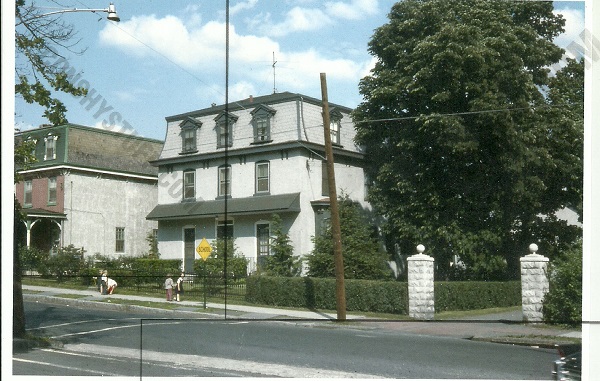
History of a House – A House with more than just History – Home to a Conshohocken Gentleman
February 18, 2020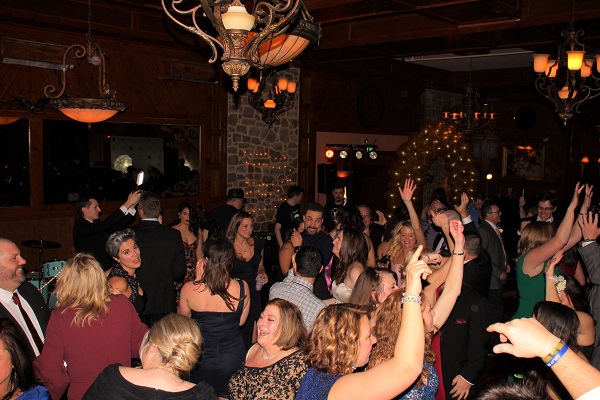
#ConshyProm – Oh What a Night it Was
February 27, 2020Black History Month – I Have a Story to Tell – by Jack Coll
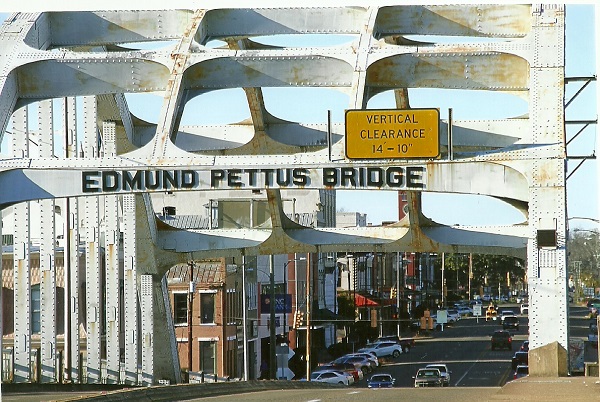
BLACK HISTORY MONTH
I Have a Story to tell
By Jack Coll
2-20-2020
Black History Month is an annual celebration of achievements by African Americans and a time to recognize the central role of Black citizens in United States History. Black History Month grew out of “Negro History Week,” the brainchild of noted historian Carter G. Woodson and other prominent African Americans.
Since 1976, every United States President has officially designated the month of February as Black History Month. Other countries around the world including Canada and the United Kingdom also devote a month to celebrating Black History.
In the 1940’s and 1950’s yearly proclamations recognizing Negro History week were proclaimed, by the late 1960’s, thanks in part to the Civil Rights movement and a growing awareness of black identity, Negro History Week had evolved into Black History Month on many college campuses.
President Gerald Ford officially recognized Black History Month in 1976, calling upon the public to “Seize the opportunity to honor the too-often neglected accomplishments of Black Americans in every area of endeavor throughout history.”
The Black History month 2020 theme, “African Americans and the vote” is in honor of the centennial anniversary of the Nineteenth Amendment, (1920) granting women’s suffrage and the sesquicentennial of the Fifteenth Amendment, (1870) giving black men the right to vote.
That brings me to my little story. On Monday, January 20, Martin Luther King Day, Donna and I were traveling through Alabama on our way to a Framing Trade Show held every year in Las Vegas NV.
As most of us know Alabama was a flash-point in the 1960’s during the Civil Rights Movement and as a self-proclaimed historian who has a deep interest in the Civil Rights Movement history I thought it would be a good idea to visit the Edmund Pettus Bridge. Actually stopping at the Edmund Pettus Bridge in Selma was a planned stop when we departed Conshohocken heading south to avoid a snow storm. Along with stops at the 16th Street Baptist Church and a brief stop at Little Rock Central High School, all Civil Rights Movement landmarks.

The bridge was built in 1940 and has four lanes on U. S. Route 80 Business over the Alabama River, from Selma on the west side, to points east. The bridge is named after Edmund Winston Pettus, born on July 6, 1821, he was the youngest of nine children and died in 1907. Pettus was a lawyer, judge, confederate brigadier general, a United States senator, and yes, head of the Alabama Ku Klux Klan. Pettus supported slavery and racism which makes the incident in 1965 all the more ironic. At one time Pettus was called “Selma’s distinguished Citizen,” thirty three years after his death the new bridge claimed his name.
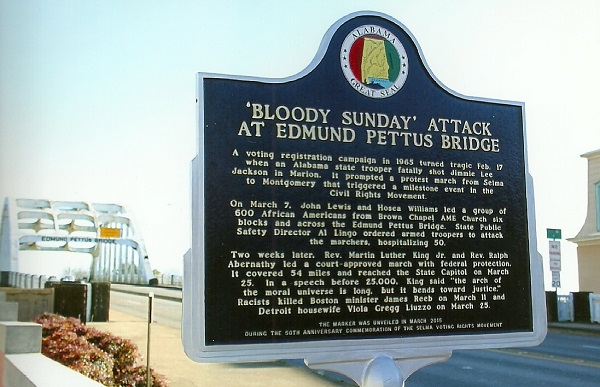
In 1965 voting rights for African Americans were a contentious issue. In Selma, voting rolls were 99% White and 1% African American, while the 1960 Census found that the population of Alabama was 30% nonwhite. In February 1965, state troopers and local enforcement in Marion, Alabama, started an armed confrontation with some 400 African American unarmed demonstrators. Jimmie Lee Jackson was shot in the stomach and he died eight days later. As word spread, the case alarmed civil rights activists, including Martin Luther King, Jr. and Southern Christian Leadership Conference ’s Director of Direct Action James Bevel. Director Bevel strategized a plan for a peaceful march from Selma to the Alabama capitol building in Montgomery, which first required crossing the Pettus Bridge leading out of Selma and onto the state highway. Many acts like this one involved killings, and many more involved economic and health problems.
On March 7, 1965, armed police attacked the unarmed peaceful civil rights demonstrators attempting to march to the state capital of Montgomery in an incident that became known as “Bloody Sunday.” Because of the design of the bridge, the protesters were unable to see the police officers on the east side of the bridge until after they had reached the top of the bridge.
The protesters first saw the police while at the center of the bridge, 100 feet above the Alabama River. Upon seeing them, protester Hosea Williams asked his fellow protester John Lewis if he knew how to swim. Despite the danger ahead, the protesters bravely continued marching. They were then attacked and brutally beaten by police and the state troopers on the other side.
Televised images of the attack presented Americans and international audiences with horrifying images of the marchers left bloodied and severely injured, and roused support for the Selma voting Rights Movement. Amelia Boynton, who had helped organize the march as well as participated in it, was beaten unconscious. A photograph of her lying on Edmund Pettus Bridge appeared on the front page of newspapers and news magazines around the world. In all, 17 marchers were hospitalized and 50 were treated for lesser injuries: the day soon became known as “Bloody Sunday” within the African American community.
I walked across the Pettus Bridge and stopped in at the African American Museum at the end of the bridge, I also stopped in the Civil Rights Memorial Park and talked with George Sallie. George was 90 years old and was on the bridge on March 7, 1965 and was beat with an Alabama State police Billy-club, the Trooper split his head wide open and the old man had the scars to show me. I wasn’t prepared to interview anyone but without thinking I said, “What was it like on the bridge on Bloody Sunday?” George replied with one word, “Scary.”
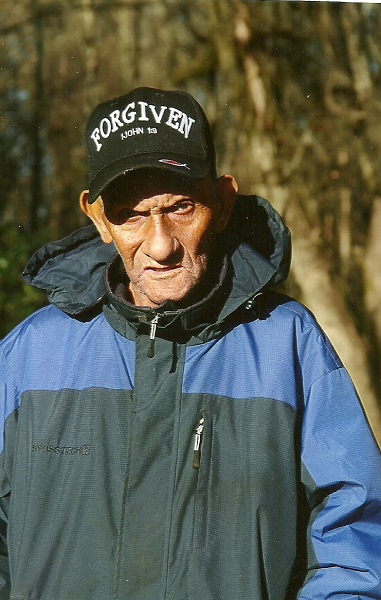
I walked slowly back across the bridge, it was a beautiful sunny day with blue skies, the temperature was hovering around 60 degrees, the Alabama River below was calm and I hung over the railing of the bridge just thinking about four little girls.
Earlier in the day Donna and I had taken a ride thru Birmingham Alabama to make a stop at the 16th Street Baptist Church. In 1963 just three weeks after Dr. Martin Luther King Jr. delivered his groundbreaking “I Have A Dream” speech, the Alabama Church was bombed before a Sunday service, killing four little girls and injuring several others.
It had happened on Sunday morning, September 15, it was much like the day I was experiencing hanging over the Alabama River from the Edmund Pettus bridge railing, it was quiet and peaceful and then the racially motivated crime, that took the life of these four little girls shattered the soft September morning.
Years ago I had seen the Spike Lee documentary film called “4 Little Girls,” I couldn’t shake the names of these girls, Addie Mae Collins, Carol Robertson, Cynthia Wesley and Denise McNair.
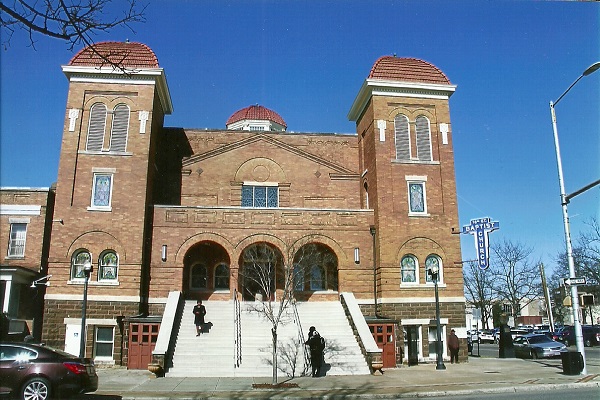
When Donna and I arrived at the 16th Street Baptist church on January 20, I parked the car and got out with my camera in hand, I stood in front of the Church where services were getting ready to start in honor of Martin Luther King Day. I couldn’t take my eyes off the front steps of the church where four Ku Klux Klan members planted the bomb, made of 15 sticks of dynamite, underneath the very steps I was staring at, it gave me chills. I thought about how that bomb shattered that peaceful September Sunday morning all those years ago.
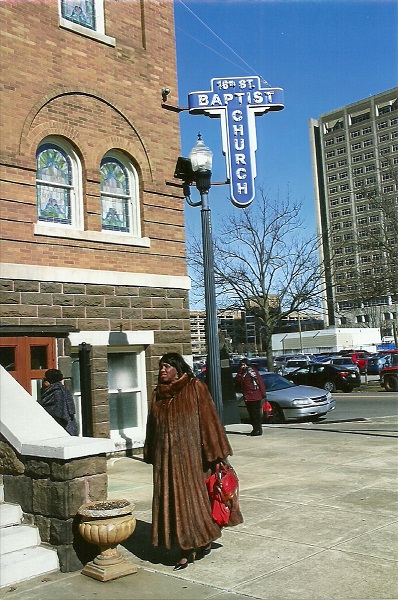
I walked inside the church, stood in the back as the church was filling with worshipers, I said four prayers for the four little girls and wondered how the parents of those girls managed to keep it together.
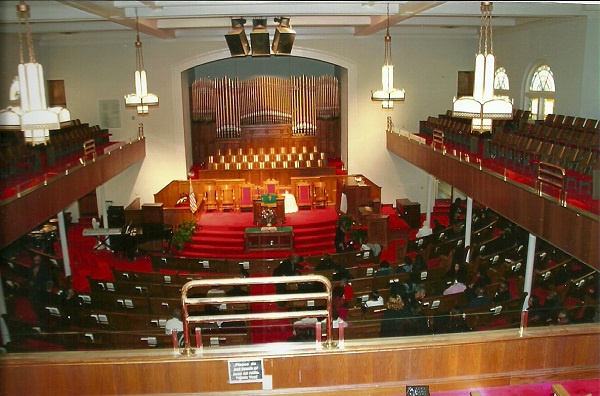
Several years ago President Obama awarded a Congressional Gold Medal posthumously to the four girls killed in 1963, presenting the medal to the Birmingham Civil Rights Institute. I remember when Obama presented that award, it was a small paragraph on like page 10 of the Daily News, I was just happy someone remembered.
A few days later I was standing in front of Little Rock Central High School in Arkansas, thinking about another September morning but in 1957, when a group of nine black students who enrolled at the formerly all-white high school in Little Rock were denied admittance. Their attendance at the school was a test of “Brown v. Board of Education,” a landmark 1954 Supreme Court ruling that declared segregation in public schools unconstitutional.
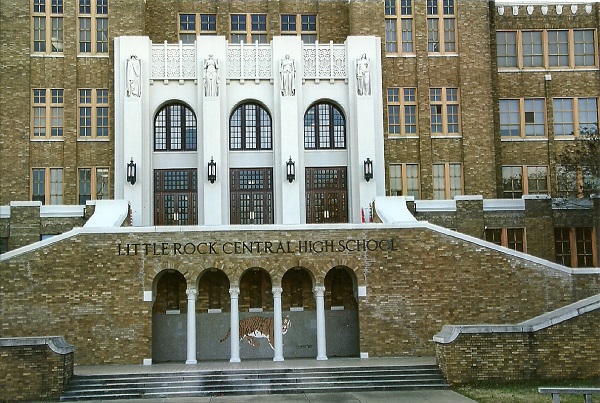
So on September 4, 1957, the first day of classes at Central High, Governor Orval Faubus called in the Arkansas National Guard to block the black student’s entry into the high school. Later that month, President Dwight D. Eisenhower sent in federal troops to escort the Little Rock Nine into the school. It drew national attention to the civil rights movement.

The group of nine had been widely recognized for their significant role in the civil rights movement. In 1999, President Clinton awarded each member of the group the Congressional Gold Medal. The nine students registered as the first African Americans to attend Central High included Minnijean Brown, Elizabeth Eckford, Ernest Green, Thelma Mothershed, Melba Patillo, Gloria Ray, Terrence Roberts, Jefferson Thomas and Carlotta Walls. They will forever be known as the “Little Rock Nine.”
As I walked off the Edmund Pettus Bridge I wondered if any of this history was being taught in our schools, anywhere in the country. I wondered if African American history was being taught at Plymouth Whitemarsh High, Upper or Lower Merion High School or any other school.
I wondered if we took 100 random high school students and asked them if they ever heard of Thurgood Marshall, Rosa Parks, the Montgomery Bus Boycott, Freedom Riders, Medgar Evers, March on Washington, the Civil Rights Act of 1964, Voting Rights Act, Malcolm X, Woolworths Lunch Counter, Bloody Sunday, and several other key moments in the civil rights movement, how many of the 100 selected students would even know what we’re talking about?
Civil Rights Movement landmarks are plenty and I’ve visited a lot of them. Perhaps the most significant Civil Rights landmark that I’ve ever visited was standing outside the hotel room of Rev. Dr. Martin Luther King Jr. at the Lorraine Motel where he was assassinated. I’ve visited the Motel several times and I find myself starring up at the bathroom window in the rooming house across the street where the shot was taken from, the rooming house is now a part of the Civil Rights Museum.
February is Black History Month, not all of the history is good history and certainly not all the history is bad history, but the civil rights history is such a rich chapter in the history of our country and the history of African Americans.
(Editor’s Note)
Portions of this article were researched through the internet quoting a number of different sites pertaining to Black History.

